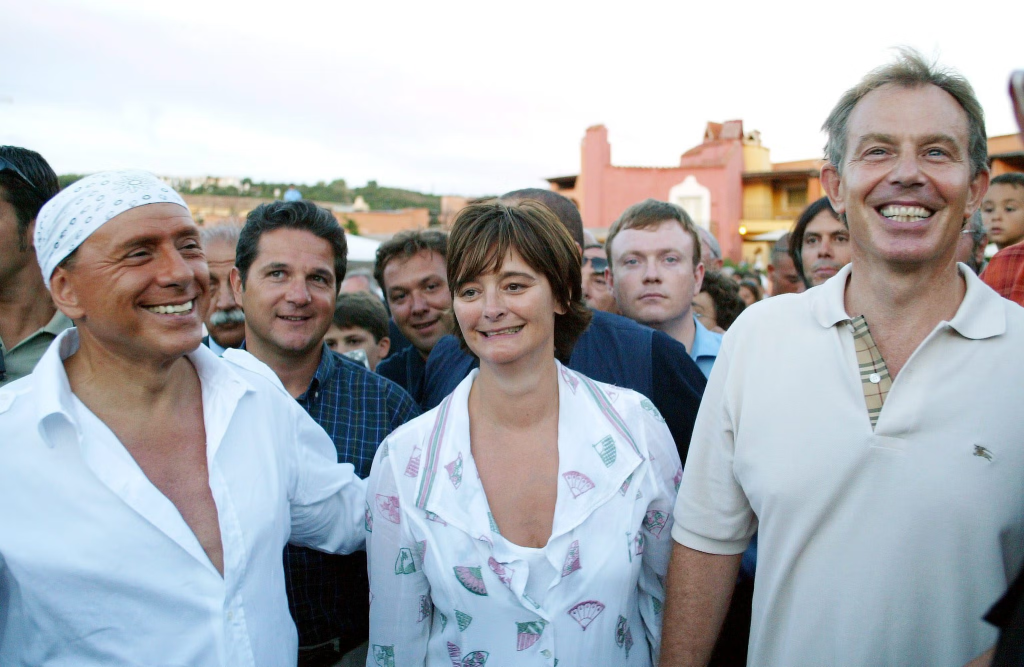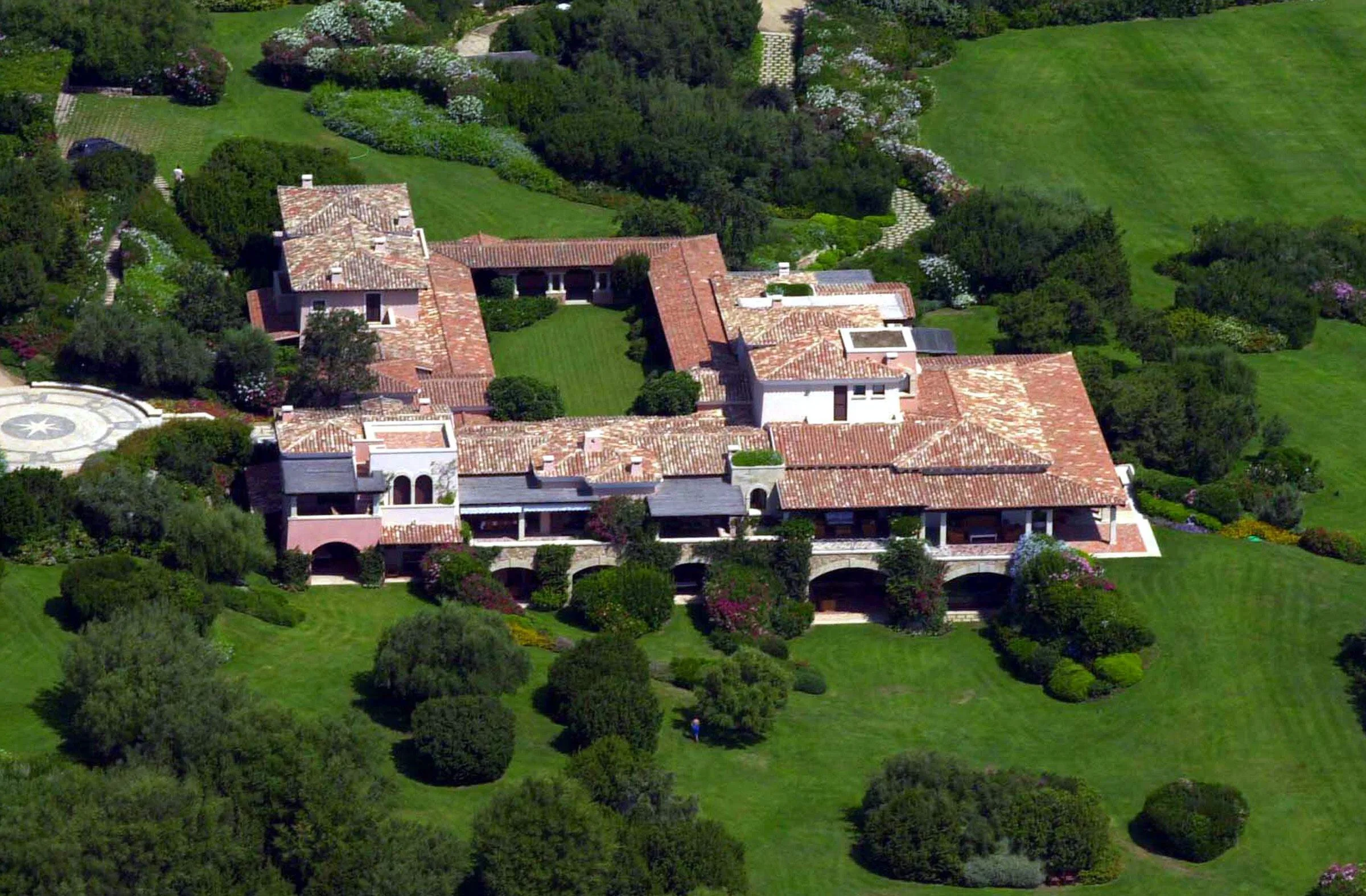Silvio Berlusconi’s iconic Villa Certosa, located on Sardinia’s northeastern coast, has been listed for sale at a staggering €500 million ($540 million), as reported by the Financial Times. The property, renowned for hosting influential figures like Russian President Vladimir Putin, is managed by real estate adviser Dils, responsible for the upcoming sale.

This asking price represents a significant increase from its 2021 appraisal, which valued the estate at €260 million. Despite the impressive price tag, sources suggest that the transaction will be kept private, with no public advertising. Potential buyers reportedly include billionaires from the UAE, Saudi Arabia, India, and the US, as well as various international luxury hospitality companies. Viewings are scheduled to commence later this month.
Villa Certosa, spanning 110 hectares, boasts 68 rooms, direct access to the Mediterranean Sea, multiple swimming pools and tennis courts, four bungalows, a gym, a greenhouse, and an amphitheater. Acquired by Berlusconi in the late 1980s, he undertook a complete reconstruction and expansion of the property. Over the years, the estate hosted numerous prominent politicians, such as former US President George Bush, ex-UK Prime Minister Tony Blair, and the late Italian tycoon himself, who passed away in June 2023.

While the CEO of Dils, Giuseppe Amitrano, and the Berlusconi family holding company spokesperson have not officially commented on the sale, reports suggest that Villa Certosa is one of several properties set to go on the market due to the escalating maintenance costs. Some assets, however, will be retained within the family, with Berlusconi’s five children sharing ownership.

Inside Silvio Berlusconi’s Controversial Villa Certosa
Perched on the emerald shores of Sardinia, nestled amidst sprawling vineyards and rugged coastlines, lies Villa Certosa – a sprawling estate that embodies the extravagant and controversial life of its former owner, Italian media mogul and politician Silvio Berlusconi. More than just a luxurious vacation home, this 170-acre property served as a playground for the rich and powerful, a stage for political summits, and a symbol of excess that sparked both awe and outrage.
A Fusion of Styles: Villa Certosa is not a single architectural style but a fascinating blend. Its core structure, a 1940s villa, was remodeled in the 1980s, incorporating Neoclassical elements like grand columns and symmetrical facades. However, Berlusconi’s love of modern luxury shines through in the expansive glass windows, sleek poolside lounging areas, and the iconic artificial volcano, a playful nod to his Neapolitan roots.
Hidden Gems: Step beyond the opulent main villa and discover a treasure trove of unique features. A secret passage leads to a private cinema, complete with plush velvet seats and state-of-the-art technology. Beneath the manicured lawns lies a hidden grotto, rumored to be inspired by Capri’s Blue Grotto, offering a cool retreat from the Sardinian sun.
A Theatrical Touch: Berlusconi, a former theater owner, incorporated his love for the dramatic into the architecture. The entrance features a cascading waterfall and dramatic lighting, creating a grand arrival experience. The discotheque boasts a rotating dance floor and elaborate stage lighting, transforming it into a dazzling performance space.
Symbolism in Stone: Look closer, and you’ll find subtle nods to Berlusconi’s personal life and political aspirations. The villa’s name, “Certosa,” references a Carthusian monastery, symbolizing both tranquility and wealth. Statues of Roman emperors and mythological figures adorn the gardens, reflecting his admiration for power and history.
Sustainable Touches: While known for its extravagance, Villa Certosa surprisingly incorporates some eco-friendly features. Solar panels generate a portion of the estate’s energy, and rainwater harvesting systems conserve water. These elements offer a glimpse into a more responsible side of Berlusconi’s vision.
A Glimpse into the Past: Exploring these architectural details and hidden features allows us to peer into the mind of Silvio Berlusconi. They reflect his love for luxury, theatricality, and even a touch of sustainability, painting a more nuanced picture of the man behind the opulent facade.
A Paradise Built on Privilege:
Purchased in the 1980s, Berlusconi poured millions into transforming the existing villa into a modern-day Xanadu. 68 opulent rooms, five swimming pools, tennis courts, a discotheque, and even an artificial volcano are just a few of the estate’s extravagant features. Rumored to have cost well over €500 million, Villa Certosa became synonymous with Berlusconi’s lavish lifestyle, drawing both admiration and criticism.
Playground for the Elite:
The estate’s guest list reads like a who’s who of international figures. World leaders like Vladimir Putin and Tony Blair enjoyed lavish receptions, while celebrities like George Clooney and Leonardo DiCaprio basked in its Mediterranean allure. The infamous “bunga bunga” parties, fueled by scantily clad women and questionable activities, further cemented the villa’s reputation as a playground for the privileged few.
Beyond the Glitz: Political Intrigue and Public Scrutiny:
Villa Certosa wasn’t just a party palace; it also hosted significant political meetings. G8 summits saw world leaders discuss crucial issues within its gilded walls, blurring the lines between private enjoyment and official business. This, coupled with the estate’s exorbitant cost and Berlusconi’s personal scandals, fueled public anger and accusations of corruption.
A Legacy of Excess and Transformation:
In 2023, the Berlusconi family announced their intention to sell the estate, marking the end of an era. Whether it remains a private haven or transforms into a luxury resort, Villa Certosa’s legacy is undeniable. It stands as a monument to Berlusconi’s flamboyant persona, a glimpse into a world of unimaginable wealth and privilege, and a reminder of the fine line between success and excess.
Beyond aesthetics, the unique design elements of Villa Certosa offer intriguing glimpses into Silvio Berlusconi’s personality and aspirations. Let’s delve deeper into the inspiration behind two of its most iconic features:
1. The Erupting Enigma: The Artificial Volcano
- Neapolitan Roots: Berlusconi, born in Naples, pays homage to his hometown through this striking centerpiece. Naples sits near Mount Vesuvius, a powerful volcano that has shaped the city’s history and identity. The artificial volcano serves as a personal and playful connection to his heritage.
- Symbol of Power and Creation: Volcanoes represent immense natural forces, often associated with creation, destruction, and rebirth. Placing a controlled eruption within his private domain might reflect Berlusconi’s self-perception as a powerful figure shaping his own destiny and even Italy’s future.
- Spectacular Entertainment: The volcano is more than just a symbol; it’s an extravagant entertainment feature. Erupting with fire and smoke, it adds a dramatic flair to poolside gatherings, showcasing Berlusconi’s penchant for creating awe-inspiring experiences for his guests.
2. The Hidden Getaway: The Grotto
- Mediterranean Enchantment: Inspired by the famed Blue Grotto of Capri, the hidden grotto offers a cool, tranquil escape within the vast estate. Capri, a luxurious island resort, represents an idyllic Mediterranean lifestyle that Berlusconi embraced and embodied. Recreating its signature blue-hued grotto brings a touch of that glamorous escape to his personal haven.
- Secrecy and Intimacy: Hidden beneath the surface, the grotto provides a secluded space for private moments away from the public eye. This desire for privacy, sometimes shrouded in controversy, was a recurring theme in Berlusconi’s life, with the grotto offering a physical manifestation of that need.
- Mythological Connection: Grottoes in mythology often served as dwellings for nymphs and other mythical creatures. This association with the fantastical and otherworldly aligns with Berlusconi’s larger-than-life persona and his desire to create a world of his own design within Villa Certosa.
With the Berlusconi family seeking buyers for Villa Certosa, speculation swirls about its future. Several possibilities exist, each with its own implications:
Luxury Resort: The most obvious path is transforming the estate into a high-end resort. Its sprawling grounds, luxurious amenities, and iconic status could attract wealthy tourists seeking an exclusive Mediterranean escape. However, challenges include preserving the villa’s unique character while making it commercially viable, and navigating potential backlash from locals concerned about increased tourism and exclusivity.
Private Residence: A wealthy individual could purchase the estate for personal use. Rumors have already linked billionaires like Jeff Bezos and Roman Abramovich to potential interest. This option would ensure privacy but leave the estate largely hidden from public view, potentially sparking public debate about accessibility and the societal impact of such immense wealth concentration.
Cultural Center or Museum: Transforming the villa into a cultural center or museum could offer public access and showcase its architectural and historical significance. Exhibitions could explore Berlusconi’s life and influence, raising questions about power, wealth, and media in modern Italy. However, concerns about maintaining the estate’s integrity and navigating potential controversies surrounding Berlusconi’s legacy could arise.
Silvio Berlusconi: A Timeline
Early Life and Business Career:
- 1936: Born in Milan, Italy
- 1960s: Graduates with a law degree and enters the construction industry. Begins acquiring media assets.
- 1974: Founds Fininvest, a media holding company that becomes Italy’s largest private broadcaster.
- 1980s: Expands Fininvest’s reach, acquiring television networks, publishing houses, and football clubs. Becomes a billionaire.
Entry into Politics:
- 1994: Founds Forza Italia, a center-right political party, in response to political corruption scandals.
- 1994-1995: Serves as Italy’s Prime Minister for the first time, but his government collapses quickly.
- 2001-2006: Wins second term as Prime Minister. Implements controversial media and economic reforms.
- 2008-2011: Elected Prime Minister for the third time. Faces domestic and international criticism for his handling of the financial crisis.
Legal Controversies and Scandals:
- Throughout his career, Berlusconi is embroiled in numerous legal battles, including allegations of bribery, corruption, and tax fraud.
- 2013: Convicted of tax fraud and sentenced to four years in prison (reduced to community service due to age).
- 2013-2019: Banned from holding public office due to fraud conviction. Returns to the European Parliament in 2019.
Later Years and Legacy:
- 2023: Passes away at the age of 86. Remains a controversial figure, admired by some for his business acumen and political leadership, but criticized by others for his scandals and authoritarian tendencies.
- 2022: Remains a Senator until his death, retaining influence within his party.
Additional Events:
- 1986: Purchases AC Milan football club and leads them to numerous domestic and international titles.
- 1990s: Becomes embroiled in the “bunga bunga” scandals, involving allegations of improper relations with young women.
- 2011: Resigns as Prime Minister amid the European sovereign debt crisis and social unrest.
Shayne Heffernan









